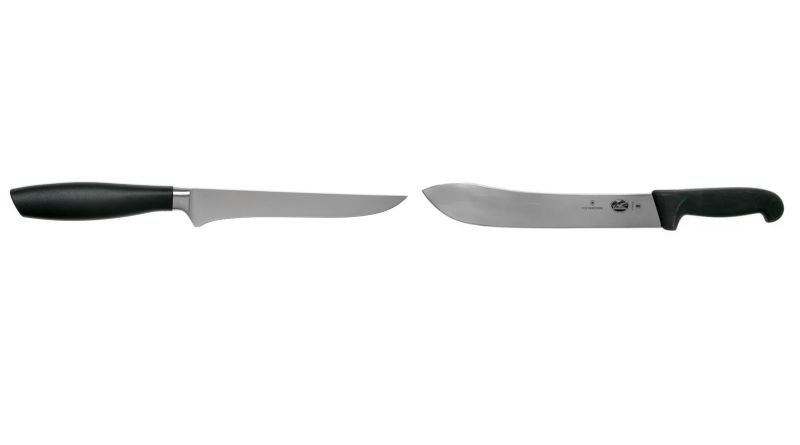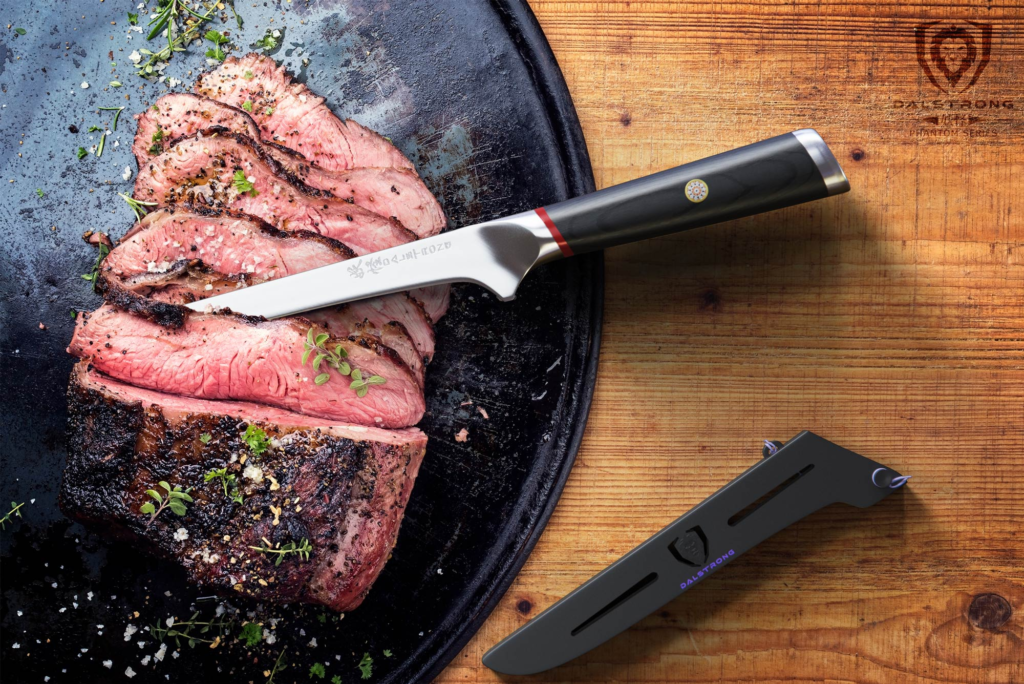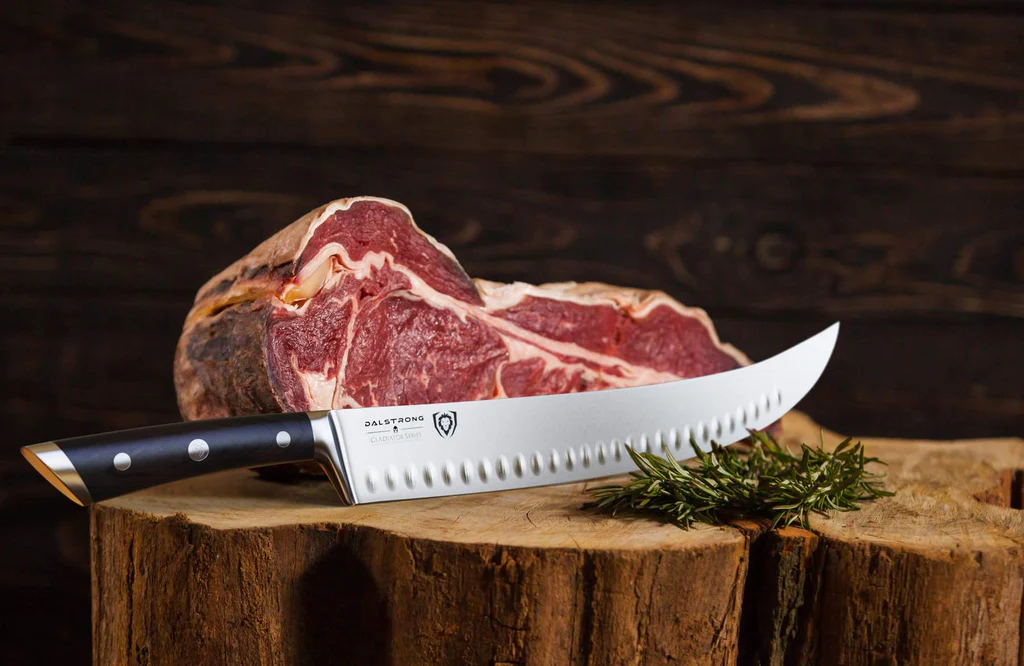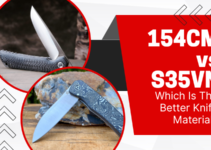Among all the different types of kitchen knives, the boning knife and the butcher knife look very much similar to each other. But they have more differences than similarities.
So, boning knife vs butcher knife, what’s the difference between them?
A boning knife is used for deboning meat, fish, and poultries, whereas butcher knife is used for cutting and slicing. Boning knives are more flexible, shorter, narrower, lighter, and thinner compared to butcher knives. This allows the boning knives to perform delicate cuts and the butcher knives to slice blocks of meat effortlessly.
We will discuss more of these knives in the upcoming sections of this article.
Boning Knife vs Butcher Knife: The Actual Difference
A boning knife and a butcher knife may look very similar and some of you may mistake one for the other one. But in reality, they have different uses and purposes.

Before we get into the dissection, let’s take a look at the short overview of their features.
| Factors | Boning Knife | Butcher Knife |
| Purpose | Deboning | Cutting or slicing |
| Blade Length | 5-7 inches | 6-14 inches |
| Blade Width | 20-30 mm | 30-40mm |
| Blade Thickness | 2-3 mm | 5-7 mm |
| Blade Shape | Usually short, narrow, curved, sharp, and pointy | Long, curved blade with a sharp point |
| Blade Flexibility | Semi | Semi (Slightly less than boning knives) |
| Weight | 3-7 oz | 4-10 oz |
| Blade Material | Stainless steel | Carbon or stainless steel |
| Finger Guard | A must-have feature | Optional |
| Cutting Technique | Requires precision | Easier and more forgiving |
| Price | Check Price on Amazon | Check Price on Amazon |
Purpose:
A boning knife is designed to remove bones and trim fat from meat, poultry, and fish, whereas a butcher knife is intended for cutting or slicing meat into smaller portions.
The thin, sharp blade of a boning knife is designed to maneuver around bones and joints with ease, making it an ideal tool for precise cuts. This knife is particularly useful for removing meat from smaller, hard-to-reach areas, such as around the ribs or the spine.
Additionally, the sharp tip of a boning knife can be used to separate tendons or connective tissue from the meat.

On the other hand, a butcher knife is designed for cutting or slicing meat into smaller portions.
This knife is generally larger and heavier than a boning knife, which makes it better suited for cutting through larger, tougher cuts of meat, such as roasts or whole chickens. A butcher knife is also useful for trimming excess fat or cutting through thicker cuts of meat.
Blade Length:
A boning knife typically has a shorter blade, ranging from 5 to 7 inches, whereas a butcher knife can have a longer blade, ranging from 6 to 14 inches.
A shorter blade on a boning knife allows for greater precision and control when working around bones and joints. It also allows for greater maneuverability in tight spaces. The narrow blade can fit easily into crevices and hard-to-reach areas, making it ideal for deboning fish or poultry.

A longer blade on a butcher knife is better for making longer cuts through larger pieces of meat. Additionally, a longer blade on a butcher knife can be helpful for using a sawing motion when cutting through tougher cuts of meat.
Blade Width:
A boning knife has a narrower blade, ranging from 20 to 30 mm, whereas a butcher knife can have a wider blade, ranging from 30 to 40 mm.
The narrow blade on a boning knife allows for easy maneuvering around bones and joints. Blade width can also impact the weight and balance of a knife. A narrower blade on a boning knife is typically lighter than a wider blade on a butcher knife, which can make it easier to control for more intricate cuts.
However, a wider blade on a butcher knife can also help to provide a better balance. A wider blade on a butcher knife typically has a straighter edge, which can help make long, straight cuts. The wider blade can also help to provide greater leverage when cutting through tough cuts of meat.
Blade Shape:
A boning knife usually has a shorter and narrower blade, whereas a butcher knife has a longer and wider blade.

The narrow, short, curved, and thin blade shape will make cutting around the bone easy for you. However, there are different types of boning knives with thicker and straighter blades. These are particularly useful for cutting heavier pieces of meat, like beef.
Butcher knives have longer, thicker, and curved blades, making the job of slicing meat effortless. The blade shape allows you to apply more strength, as the function of these blades is to power through larger pieces of meat.
Blade Flexibility:
Both boning knives and butcher knives have semi-flexible blades, allowing for greater precision and control when making cuts.
A highly flexible blade can be useful when making precise cuts around bones and joints, as it allows the user to maneuver the blade more easily. However, a blade that is too flexible may not provide enough stability or control, which can lead to uneven cuts or even accidents.
Boning knives typically have a moderately flexible blade, allowing for the necessary precision and control when making intricate cuts. The level of flexibility in a boning knife’s blade can vary depending on the specific task at hand, with some models featuring a more rigid blade for tougher cuts of meat.
Butcher knives, on the other hand, typically have a slightly less flexible blade than a boning knife. This added rigidity provides greater stability when making long, even cuts through larger pieces of meat. However, the blade is still flexible enough to allow for some maneuverability when working around bones and joints.
Blade Material:
A boning knife usually has a stainless steel blade and a butcher knife can have either carbon or stainless steel.
Boning knives usually have stainless steel blades, which are durable and easy to maintain. This type of blade material is particularly useful for boning knives, as they are often used to work with raw meat, poultry, and fish. The stainless steel material is resistant to corrosion and rust, making it less likely to become damaged or compromised over time.
Additionally, stainless steel blades can maintain their sharpness for longer periods, which is crucial when working with meat that requires precise cuts. The sharp blade allows for easy maneuvering around bones and joints, reducing the risk of accidentally cutting through bone or damaging the meat.
Carbon steel blades are known for their exceptional sharpness and edge retention, which makes them ideal for slicing through tough cuts of meat. However, they are more prone to rust and corrosion, and they require more maintenance to keep them in good condition.
Some butcher knives have a combination blade, with a carbon steel core and a stainless steel outer layer. This type of blade provides the best of both worlds, with the sharpness and edge retention of carbon steel and the corrosion resistance of stainless steel.
Weight:
A boning knife is typically lighter, weighing between 3 to 7 oz, while a butcher knife can weigh between 4 to 10 oz.
A boning knife with a lighter weight can provide better control, especially when making intricate cuts. The weight of the knife allows for easier handling and maneuvering, making it easier to work around bones and joints without damaging the meat. A lighter knife can also reduce hand fatigue and strain during extended use.
On the other hand, a heavier butcher knife can provide greater stability and leverage when making longer cuts through larger pieces of meat.
The weight of the knife can help to provide the necessary force to make cuts through tougher meats. The added weight can also help to reduce the amount of pressure and force that needs to be applied by the user.
Finger Guard:
In terms of finger guards, boning knives are more likely to have them than butcher knives.
This is because the narrow blade of a boning knife requires a closer grip, which can put your fingers in closer proximity to the blade. A finger guard on a boning knife can help prevent accidental cuts to your fingers.
Butcher knives, on the other hand, typically have wider blades and longer handles, which can make it easier to maintain a safe grip without the need for a finger guard. However, some butcher knives do still have finger guards, especially those designed for more heavy-duty tasks.
Boning Knife vs Butcher Knife: Which Is For Whom?
If you frequently prepare smaller cuts of meat, a boning knife is the way to go. If you prepare larger cuts of meat or poultry, a butcher knife will be more suitable. Ultimately, having both knives in your kitchen can be useful for a range of tasks and will allow you to tackle any meat preparation with ease.
A boning knife is perfect for those who work with meat, poultry, or fish that require intricate cuts around bones or joints. If you frequently prepare dishes like deboned chicken, filet of fish, or trimmed steak, a boning knife should be your go-to tool. The narrow, curved blade allows for precise cuts with minimal waste, and the flexibility of the blade enables easy maneuvering around bones and joints.
On the other hand, a butcher knife is ideal for those who need to cut larger pieces of meat or poultry, such as a roast or a whole chicken. If you are a professional chef or home cook who regularly prepares large cuts of meat, a butcher knife will make your job easier. Longer, curved blades provide greater leverage when making long, even cuts, and wider blades can also provide greater leverage when cutting through tougher meats.
Frequently Asked Questions (FAQs):
Can You Use A Fillet Knife As A Boning Knife?
Yes, you can use a fillet knife as a boning knife. But using a fish fillet knife as a boning knife is not recommended as it may not be suitable for the task at hand. Fish fillet knives are designed specifically for filleting fish, and while they may be able to remove small bones, they are not as versatile as a boning knife.
What type of knife is best for trimming meat?
For trimming meat, a paring knife is a great option as it has a small and pointed blade that can easily maneuver around tight spaces and trim off small bits of fat or connective tissue. In addition to a paring knife, a utility knife or chef’s knife with a sharp tip can also be useful for trimming meat.
Do butcher knives cut bone?
Yes, butcher knives can be used to cut through bone, as they are designed to handle larger cuts of meat that may include bone. However, it’s important to note that not all butcher knives are created equal, and some may be better suited for cutting through bone than others depending on the thickness and hardness of the bone.
Conclusion
Between boning knife vs butcher knife, both are essential tools in any kitchen. While they may look similar, each knife has its unique design and purpose.
The boning knife excels at intricate tasks, meanwhile, the butcher knife is best suited for cutting through large chunks of meat. Ultimately, choosing the right knife depends on the specific task at hand, and having both knives available can make a significant difference in the efficiency and quality of your meat preparation.





![Espresso Puck Stuck To Grouphead [5 Reasons & Easy Solutions] Espresso Puck Stuck To Grouphead [5 Reasons & Easy Solutions]](https://reviewnery.com/wp-content/uploads/2023/03/espresso-puck-stuck-to-grouphead-211x150.webp)
